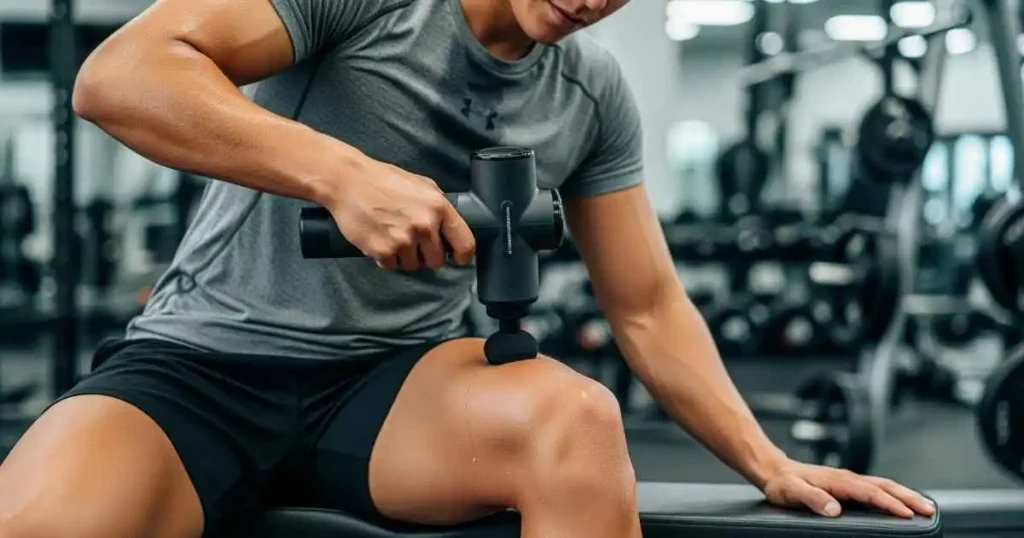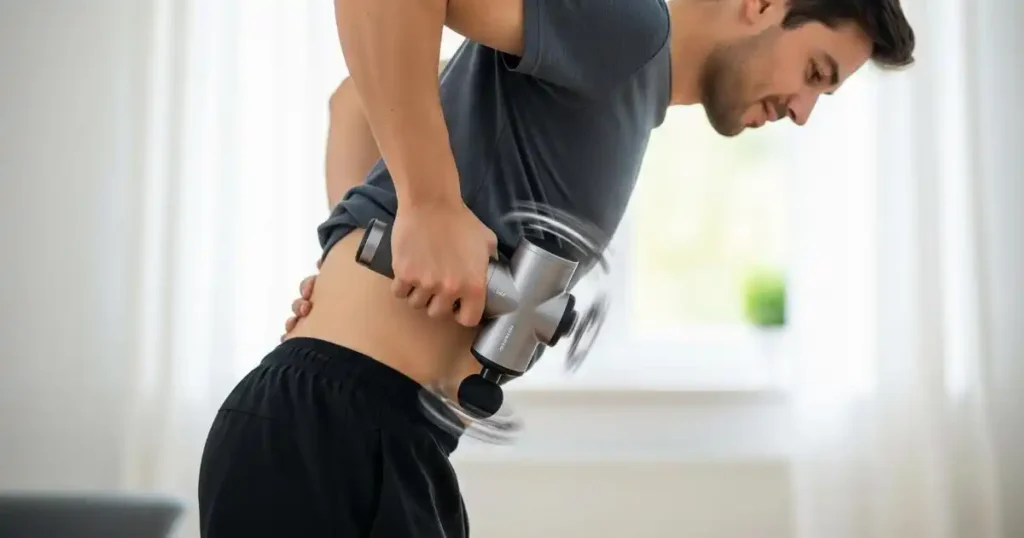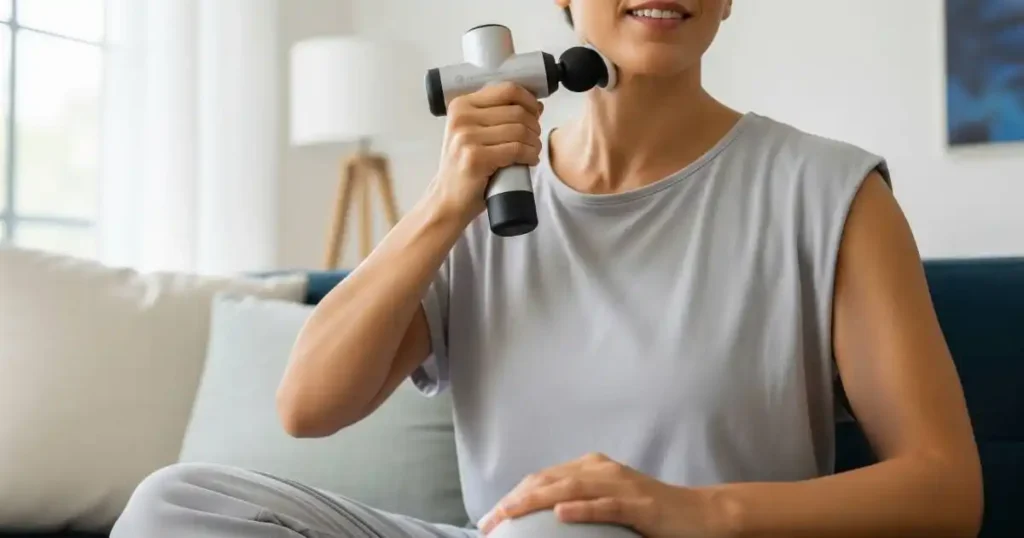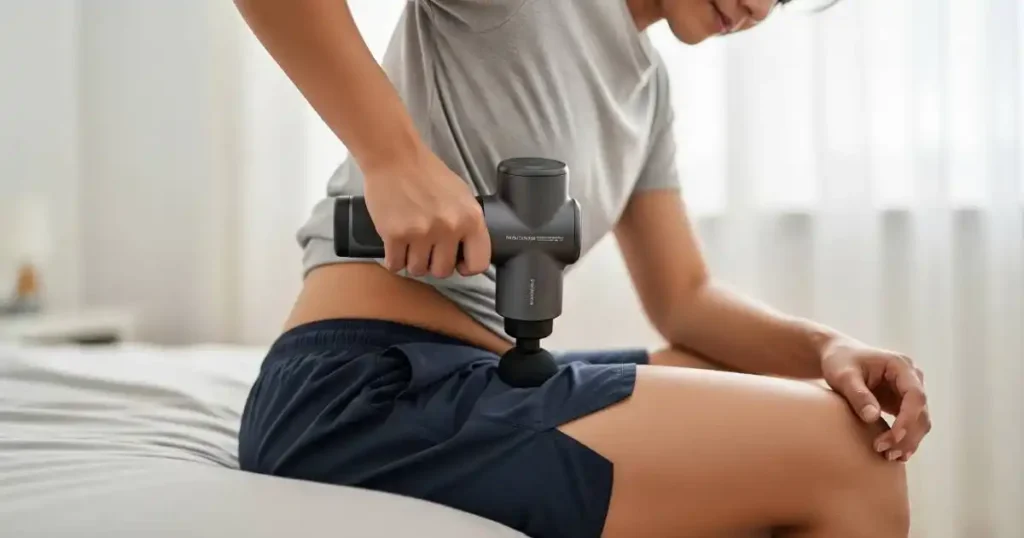At Fitness Tips Expert, our team has tested and monitored the use of massage guns with clients during personal training and recovery sessions. These handheld devices use rapid percussion to relax tight muscles, improve circulation, and support faster healing.
Many of our clients ask about using a massage gun for lower back pain, tennis elbow, or sciatica pain. That’s why we’ve created this guide to explain when and how a massage gun can be effective, and what safety tips to follow.
With growing popularity among athletes and everyday users, massage guns have proven to be valuable tools for pain relief, mobility, and flexibility. Our experts continue to recommend them as part of a well-rounded recovery routine.

What You’ll Learn
Benefits of Using a Massage Gun
Improved Blood Circulation and Muscle Recovery
When we use a massage gun with our clients, the first thing we notice is improved blood flow.
Better circulation delivers oxygen and nutrients to your muscles, which speeds up recovery. If you’ve ever felt tight or heavy after training, you’ll notice how much quicker your body bounces back when circulation improves.
Benefits of Massage Gun on Legs
You’ve probably wondered about the benefits of a massage gun on legs and for good reason.
Your quads, calves, and hamstrings take on a lot of stress from workouts and daily movement.
We often recommend clients spend a few minutes on each muscle group, because it reduces soreness, improves flexibility, and keeps your legs feeling light instead of fatigued.
Helps Reduce Muscle Soreness, Stiffness, and Fatigue
We know how frustrating it is to wake up sore or stiff after a workout.
A massage gun can help break up muscle tension, ease knots, and give you fast relief from fatigue.
Many of our athletes use it before training as a warm-up and after workouts to speed recovery—you can do the same at home.
General Safety Considerations
Before you start, a quick reminder: don’t press the massage gun directly on joints, bones, or injured areas.
Keeping sessions short 1–2 minutes per muscle group is usually enough.
Start on a low setting, listen to your body, and if you have a medical condition, check with your doctor first.
This way, you’ll get all the benefits without the risks.

Massage Gun for Specific Conditions & Areas
Massage Gun for Lower Back Pain
Lower back pain is one of the most common issues we see, often caused by sitting too long, poor posture, or overtraining.
Using a massage gun for lower back pain can release tight muscles and improve circulation in that area.
To do it safely, place the device on the muscles alongside your spine (not directly on the spine itself) and move slowly for 1–2 minutes.
If you’ve searched how to use a massage gun for lower back pain, start on the lowest setting and avoid pressing too hard—gentle pressure is usually enough.
Massage Gun for Tennis Elbow
Tennis elbow happens when the tendons around your elbow get inflamed from repetitive movements.
A massage gun can help by loosening the forearm muscles that put strain on the elbow joint. Use a soft attachment and light setting, moving around the forearm rather than directly on the joint.
This helps reduce tension and supports recovery.

Massage Gun for Lymphatic Drainage
Your lymphatic system plays a key role in removing toxins and reducing swelling.
Gentle massage can support that process, and a massage gun used on the lowest speed may help stimulate drainage. Glide it lightly over areas like arms, legs, and underarms in the direction of lymph flow.
Always avoid pressing too deeply, since the goal here is light stimulation, not deep muscle work.
Massage Gun for Feet
If you deal with plantar fasciitis, sore arches, or tired feet, a massage gun can be a game-changer.
It helps reduce inflammation, improve circulation, and relax tight muscles in your soles. We recommend using a round or ball attachment and gliding it slowly across the bottom of your foot for 1–2 minutes.
For sore arches, focus on the middle area, and for heel pain, work gently around not directly on the heel bone.
Massage Gun for Hip Flexors & Hip Pain
Tight hips are common, especially if you sit for long hours or train hard.
A massage gun can ease hip flexor tension and reduce hip pain by relaxing deep muscle tissue. Place the gun just above your thigh crease and along the outer hip. Use short sessions and avoid pressing directly on the hip bone.
Many of our clients report improved mobility and reduced stiffness after just a few uses.
Massage Gun for Knee Pain
Knee pain often comes from overuse, inflammation, or tight surrounding muscles.
While you should never place the gun directly on the kneecap, it can be helpful when used on the quads, hamstrings, and calves around the knee joint. This helps take pressure off the knee.
However, if your pain is from a serious injury or swelling, skip the massage gun and consult a doctor first.

Massage Gun for Sciatica Pain
Sciatica pain is different from regular back pain; it’s caused by irritation of the sciatic nerve, leading to pain down the leg.
A massage gun won’t “fix” sciatica, but it may relieve pressure by loosening tight glutes, hamstrings, and lower back muscles.
Focus on the muscles around the pain, not directly on the nerve. Start light, and if pain worsens, stop immediately.
Massage Gun for Achilles Tendonitis
Achilles tendonitis is caused by strain or overuse of the tendon at the back of your ankle.
A massage gun can help by increasing blood flow to the surrounding calf muscles, reducing tension. Use a low setting and avoid pressing directly on the tendon work around it instead, especially the calves.
This helps support recovery without adding strain.
Massage Gun for Cellulite (Before and After Results)
Some people use massage guns to reduce the appearance of cellulite.
The idea is that improved circulation and lymphatic flow may temporarily smooth the skin. While results vary, a massage gun can make the skin feel firmer after consistent use.
Safety Tips and Best Practices
When Not to Use a Massage Gun
From our experience, massage guns are not suitable for every situation.
Avoid using them directly on bones, joints, open wounds, or areas with severe swelling. If you have recent injuries, fractures, or circulation issues, skip the massage gun until cleared by a doctor.
Pregnant women or individuals with medical implants should also be cautious.
Correct Duration, Pressure, and Settings
More pressure does not mean better results.
We guide our clients to start on the lowest setting and limit use to 1–2 minutes per muscle group. Keep the device moving slowly instead of pressing in one spot.
This prevents bruising and ensures you get the benefits without overstimulation.
Consulting a Professional if You Have Chronic Pain
If you’re dealing with ongoing pain such as arthritis, sciatica, or tendon injuries, we always recommend speaking to a physical therapist or healthcare professional first.
A massage gun can be helpful, but it should complement not replace proper treatment.
- 12 Week Beginner Workout Routine for Women (Free PDF Plan Included)
- Cardio Workout for Guys – Complete Routine
- Workout Routine for Men Over 50: Fitness That Works
- Do Massage Guns Work Like They Claim?
- Biotin Tablets: Benefits, Usage, and Price
Final Thoughts
Massage guns have become one of the most versatile recovery tools we use with clients. From improving circulation and reducing stiffness to easing pain in specific areas like the lower back, feet, and hips, the benefits are wide-ranging.
When used correctly and consistently, they can speed up recovery, enhance mobility, and make everyday movement more comfortable.
1 thought on “Massage Gun For Pain Relief & Recovery: Complete Guide”